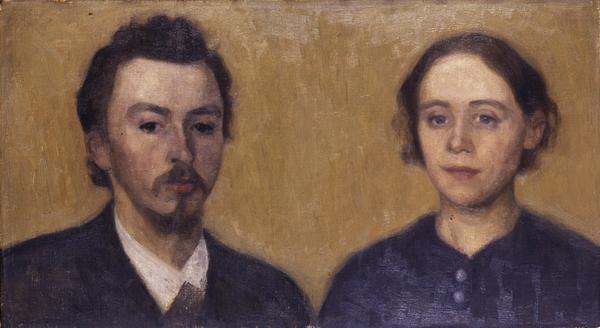In September 1891, Vilhelm Hammershøi married Ida Ilsted (1869–1949), sister of the painter Peter Ilsted, whom Hammershøi knew from the Royal Danish Academy of Fine Arts. After the wedding, the newlyweds set out for Paris via the Netherlands and Belgium. They spent six months in the French capital, where Hammershøi conducted extensive studies at the Louvre. In January 1892 he began this double portrait, on which he worked intensely until a few days before the couple travelled back to Denmark in March of that year.
The painting is one of very few double portraits that Hammershøi created of himself and his wife. In this work, they are both depicted from the front in a bust-like format, shown side by side – shoulder to shoulder – in the rectangular pictorial space. Neither is accentuated over the other, and no distinctive traits attract any special attention to either of them. And yet. There is a difference in the effects of shadow and light employed on their faces: Vilhelm Hammershøi’s face is divided into two – one part is in shadow, the other in light – whereas Ida Hammershøi’s face is evenly illuminated, devoid of shadow. The effect conveys a feeling that the double portrait is a construction and that the couple do not occupy the same space.
With the neutral ochre-coloured background, the even lighting and the everyday clothes, the double portrait seems undramatic. At the same time, there is something enigmatic about the newlyweds’ empty stares. Vilhelm Hammershøi does not convey any of the emotional intimacy and closeness expected between a newlywed couple. Rather, they seem more closely connected with their own inner world than with each other.
Hammershøi created a total of five paintings during the time in Paris and in all of them we see him working with frontal views, subjects running parallel to the picture plane and an absence of psychological empathy. Some critics have pointed out that these traits clearly underscore the great inspiration he found in the Collection of Egyptian, Greek and Roman Art at the Louvre.
[1] Others assert that photography has also had a certain impact on the artistic imagery and results from Paris, as Ida and Vilhelm Hammershøi brought along a camera and used it frequently.
[2]
Inv. no. B 313
Published in:
Alfr. Bramsen: Vilhelm Hammershøis Arbejder. Fortegnelse, København 1900, cat.no. 48;
Fortegnelse over arbejder af Vilhelm Hammershøi, [1], Kunstforeningen April 1916, København 1916, cat.no. 84, p. 10;
Sophus Michaëlis and Alfred Bramsen: Vilhelm Hammershøi. Kunstneren og hans værk, København 1918, cat.no. 104, pp. 51, 89;
Erik Zahle: ”Malerisamlingens vækst” in C.L. Davids Samling, Tredje del, København 1958, pp. 127, 162-163;
C.L. David: C.L. Davids Samling, København 1960, p. 27 (mentioned);
Knud Voss and Verner Aspenström: Vilhelm Hammershøi, Prins Eugens Waldemarsudde, Stockholm 1976, cat.no. 9, p. 41;
Hanne Finsen, Inge Vibeke Raaschou-Nielsen: Vilhelm Hammershøi: en retrospektiv udstilling, Ordrupgaard, Charlottenlund 1981, cat.no. 40, ps. 70;
Bente Scavenius: Den frie Udstilling i 100 år, København 1991, p. 23;
Poul Vad in Kjeld von Folsach and Nana Lund (eds.): Dansk kunst i Davids Samling – fra Philipsen til Saxbo, København 1995, cat.no. 31, pp. 92-93;
Eva Pohl: Blikket i spejlet: selvets spejling i kunstnerromaner og selvportrætter fra 1880-1914, Odense 2002, fig. 31, pp. 153-154;
Felix Krämer, Ulrich Luckhardt, Barbara Ludwig: Vilhelm Hammershøi, Hamburger Kunsthalle, Hamburg 2003, cat.no. 13, pp. 39, 150;
Poul Vad: Hammershøi. Værk og liv, København 2003, 5. ed., pp. 128-132, 352;
Tone Sinding Steinsvik, Ida Lorentzen, Bente Scavenius: Den forunderlige stillheten: Ida Lorentzen (f.1951), Vilhelm Hammershøi (1864-1916), Stiftelsen Modums Blaafarveværk, Modum 2005, cat.no. 32, pp. 63, 76;
Anne-Sophie Rasmussen: Vilhelm Hammershøi. Stilhedens maler, Odense 2015, p. 26;
Henrik Wivel: Hammershøi i Davids Samling, København 2017, pp. 23-24, 58-59;
Eva Pohl: ”Se Hammershøi over skulderen” in Nordisk Tidsskrift, 2018, 1, p. 15-16;
Annette Rosenvold Hvidt and Gertrud Oelsner: Vilhelm Hammershøi. På sporet af det åbne billede, København 2018, pp. 444-446, 495, 499;
Lisbeth Smedegaard Andersen: Gådefuld bør man være: Vilhelm Hammershøi og inspirationen fra Søren Kierkegaard, København 2019, Cover, front and back;
Annette Rosenvold Hvidt and Gertrud Oelsner (eds.): Fremkaldelser. Vilhelm Hammershøi, Valdemar Schønheyder Møller og fotografiet, Den Hirschsprungske Samling, København 2021, ill. 64, pp. 61-62;
Kathrin Baumstark (ed.): Nolde und der Norden, Bucerius KUNST Forum, Hamburg 2021, cat.no. 6, pp. 86, 189;
Camilla Klitgaard Laursen, Mette Bøgh Jensen, Signe Havsteen (eds.): Marie Krøyer, Skagens Museum, Den Hirschsprungske Samling and Prins Eugens Waldemarsudde, Skagen 2023, p. 80 and Ill. 53;
